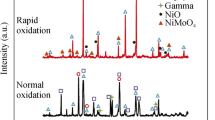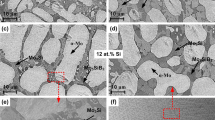Abstract
The isothermal-oxidation behavior of three oxide-dispersion-strengthened (ODS) alloys, viz., MA 956, ODM 751, and PM 2000, has been examined in air at 1200°C for exposure times up to 4800 hr. During exposure all the alloys formed an external scale of alpha alumina (α-Al2O3). The growth rate of alumina on MA 956 was significantly faster than that formed on ODM 751 resulting in an oxide layer which was about twice as thick after 4800 hr. The oxide-grain morphology on MA 956 was essentially equiaxed containing irregularly shaped, titanium-rich particles, whereas the oxide formed on ODM 751 was slightly finer, distinctly columnar and contained elongated yttrium-rich particles. Spalling of the oxide layer occurred after approximately 2400 hr on MA 956, whereas only slight spalling occurred on ODM 751 even after the longest exposure time. Experiments revealed that the initial surface roughness of PM 2000 can contribute significantly to spalling by enabling the growth of highly convoluted scale layers which are mechanically unstable under compressive stresses (buckling). Internal porosity is also observed in all three alloys after exposure. The pores were generally spherical with small Ti-, Al-, Y-rich particles distributed over their internal surfaces. The amount of porosity increases to a maximum and then slowly decreases.
Similar content being viewed by others
References
R. C. Klug, G. Krauss, D. K. Matlock, and F. S. Saurez,Heat Resistant Materials (Proc. Conf.), Fontana, WI, 1991, p. 61.
D. Ruluff and P. E. Mcintyre,Mater. Eng. Feb., 34 (1982).
R. C. Benn,Frontiers of High Temperature Materials II (Proc. Conf.), Inco Alloy International, 1983, p. 37.
W. J. Quadakkers, H. Holzbrecher, K. G. Briefs, and H. Beske,The Role of Active Elements in the Oxidation Behaviour of High Temperature Metals and Alloys, E. Lang (ed.) (Elsevier Applied Science, 1989), p. 155.
T. A. Ramanarayanan, R. Ayer, R. Petrovic-Luton, and D. P. Leta,Oxid. Met. 29, 445 (1988).
T. A. Ramanarayanan, M. Raghavan, and R. Petrovic-Luton,J. Electrochem. Soc. 131, 923 (1984).
W. J. Quadakkers,Werkst. Korros. 41, 659 (1990).
H. Nickel and W. J. Quadakkers,Heat Resistant Materials (Proc. Conf.), Fontana, WI, 1991, p. 87.
M. J. Bennett, H. romary, and J. B. Price,Heat Resistant Materials (Proc. Conf.), Fontana, WI, 1991, p. 95.
D. M. Macdonald,Frontiers of High Temperature Materials I (Proc. Conf.), Inco Alloy International, New York, 1991, p. 101.
G. H. Gessinger,Powder Metallurgy of Superalloys (Chap. 7) (Butterworths, 1984), p, 280.
I. G. Wright and M. S. Seltzer,Met. Trans. 4, 441 (1973).
B. Lunsman,Trans. Mater. Soc. AIME 188, 995 (1950).
K. L. Luthra and L. C. Briant,Oxid. Met. 26, 397 (1986).
J. M. Francis and W. H. Whitlow,Corros. Sci. 5, 701 (1965).
H. Pfeiffer,Werkst. Korros. 8, 754 (1957).
D. P. Moon,Mater. Sci. Technol. 5, 755 (1989).
F. A. Golightly, F. H. Stott, and G. C. Wood,Oxid. Met. 10, 163 (1976).
Per Kofstad,High Temperature Corrosion (Elsevier Applied Science, 1988), p. 389.
A. H. Rosenstein, J. K. Tien, and W. D. Nix,Met. Trans. 17A, 151 (1986).
J. D. Whittenberger,Met. Trans. 3, 3038 (1972).
C. S. Giggins and F. S. Pettit,Met. Trans. 2, 1071 (1972).
H. D. Hendrich,New Materials by MA Techniques (Proc. Conf.), E. Artz and L. Schultz (eds.) (Calw-Hirasu, 1988), p. 217.
R. Berglund and B. Jonsson,Indust. Heating 56, 10 (1989).
G. Korb,New Materials by MA Techniques (Proc. Conf.), E. Artz and L. Schultz, eds. (Claw-Hirasu, 1988), p. 175.
M. J. Bennett and M. R. Haulton,High Temp. Mater. Power Eng. Part 1, 227 (1990).
P. Tomaszewicz and G. R. Wallwork,Oxid. Met. 20, 75 (1983).
M. J. Bennett and A. S. Tuson, AEA Ind. Tech. Harwell Laboratory, Report AERE R 13309.
T. A. Ramanarayanan, M. Raghavan, and R. Petrovic-Luton,Oxid. Met. 22, 83 (1984).
J. Stringer,Corros. Sci. 10, 513 (1970).
K. T. Feber and A. G. Evans,Acta Met. 31, 565 (1983).
J. K. Tien and F. S. Pettit,Metal. Trans. 3, 1587 (1972).
M. J. Bennett, R. Perkins, J. B. Price, and J. A. Desport, AEA Ind. Tech. Harwell Laboratory, Report AEA-In Tec-1143, 1992.
Author information
Authors and Affiliations
Rights and permissions
About this article
Cite this article
Turker, M., Hughes, T.A. Oxidation behavior of three commercial ODS alloys at 1200°C. Oxid Met 44, 505–525 (1995). https://doi.org/10.1007/BF01051041
Received:
Revised:
Issue Date:
DOI: https://doi.org/10.1007/BF01051041




